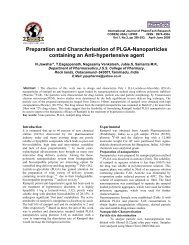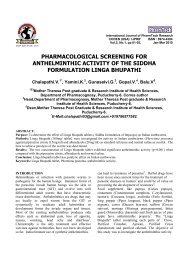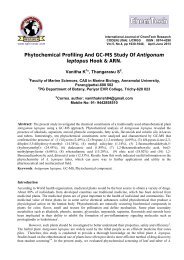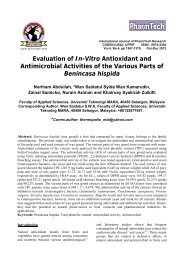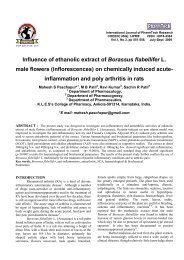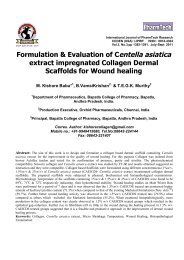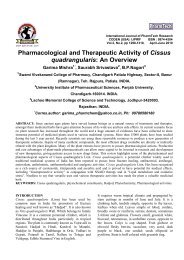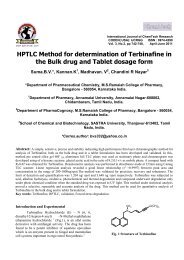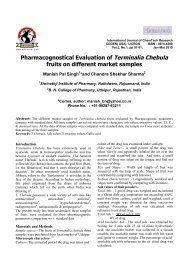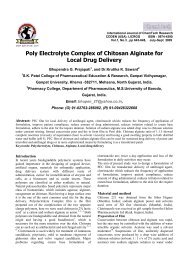Antibacterial and Preliminary Phytochemical Screening on the ...
Antibacterial and Preliminary Phytochemical Screening on the ...
Antibacterial and Preliminary Phytochemical Screening on the ...
You also want an ePaper? Increase the reach of your titles
YUMPU automatically turns print PDFs into web optimized ePapers that Google loves.
M.S. Khyade et al /Int.J. PharmTech Res.2010,2(1) 516<br />
Preparati<strong>on</strong> of extracts <str<strong>on</strong>g>and</str<strong>on</strong>g> phytochemical<br />
screening<br />
The dried plant material was pulverized into<br />
fine powder using a grinder (mixer). About 50 gm of<br />
powdered material was extracted in soxhlet extracti<strong>on</strong><br />
apparatus with 250 ml of each of <strong>the</strong> following<br />
solvents; Petroleum e<strong>the</strong>r, chloroform, Acet<strong>on</strong>e <str<strong>on</strong>g>and</str<strong>on</strong>g><br />
Methanol [15] . The extracts obtained with each solvent<br />
were filtered through Whatman filter paper No. 1 <str<strong>on</strong>g>and</str<strong>on</strong>g><br />
<strong>the</strong> respected solvents were evaporated (at 40ºC) with<br />
<strong>the</strong> help of heating mantle. The sticky greenish-brown<br />
substances were obtained <str<strong>on</strong>g>and</str<strong>on</strong>g> stored in refrigerator<br />
<str<strong>on</strong>g>and</str<strong>on</strong>g> were suspended in dimethyl sulphoxide (DMSO)<br />
for prior to use [16] .<br />
Some of <strong>the</strong> extracts were used for <strong>the</strong><br />
qualitative phytochemical screening for <strong>the</strong><br />
identificati<strong>on</strong> of <strong>the</strong> various classes of active chemical<br />
c<strong>on</strong>stituents, using st<str<strong>on</strong>g>and</str<strong>on</strong>g>ard prescribed methods [17-19] .<br />
The positive tests were noted as weak (+), moderate<br />
(++), str<strong>on</strong>g (+++) <str<strong>on</strong>g>and</str<strong>on</strong>g> absent (-).<br />
Tested microorganisms<br />
Various cultures of human pathogenic, gram<br />
positive <str<strong>on</strong>g>and</str<strong>on</strong>g> gram negative bacteria were used. These<br />
are Staphylococcus aureus, Bacillus megaterium,<br />
Bacillus subtilis, Escherichia coli, Salm<strong>on</strong>ella typhi,<br />
Pseudom<strong>on</strong>as aeruginosa, Corynobacterium<br />
glutamicum <str<strong>on</strong>g>and</str<strong>on</strong>g>, Klebsella planticola. The cultures<br />
were obtained from Microbial Type culture Collecti<strong>on</strong><br />
(MTCC), IMTEC, Ch<str<strong>on</strong>g>and</str<strong>on</strong>g>igarh, India. The<br />
microorganisms were repeatedly subcultured in order<br />
to obtain pure isolates. A loop full test organism was<br />
inoculated <strong>on</strong> nutrient broth <str<strong>on</strong>g>and</str<strong>on</strong>g> incubated for 24 h at<br />
37±1ºC <str<strong>on</strong>g>and</str<strong>on</strong>g> maintained in sterile c<strong>on</strong>diti<strong>on</strong>.<br />
<str<strong>on</strong>g>Screening</str<strong>on</strong>g> for antibacterial properties<br />
<str<strong>on</strong>g>Antibacterial</str<strong>on</strong>g> activities of plant extracts were<br />
tested by Agar well diffusi<strong>on</strong> method [20] . The culture<br />
plates were prepared by pouring 20 ml of sterile<br />
nutrient agar.1 ml inoculum suspensi<strong>on</strong> was spread<br />
uniformly over <strong>the</strong> agar medium using sterile glass rod<br />
to get uniform distributi<strong>on</strong> of bacteria. A sterile cork<br />
borer (8 mm) was used to make wells in each plate for<br />
extracts. These plates were labeled <str<strong>on</strong>g>and</str<strong>on</strong>g> 100µl of each<br />
plant extracts (at c<strong>on</strong>centrati<strong>on</strong> of 50,100 mg/ml) was<br />
added aseptically into <strong>the</strong> well. Then <strong>the</strong> plates were<br />
incubated for 24 h at 37ºC during which <strong>the</strong> activity<br />
was evidenced by <strong>the</strong> presence of z<strong>on</strong>e of inhibiti<strong>on</strong><br />
surrounding <strong>the</strong> well. Each test was repeated three<br />
times <str<strong>on</strong>g>and</str<strong>on</strong>g> <strong>the</strong> antibacterial activity was expressed as<br />
<strong>the</strong> mean of diameter of <strong>the</strong> inhibiti<strong>on</strong> z<strong>on</strong>es (mm)<br />
produced by <strong>the</strong> plant extracts when compared to <strong>the</strong><br />
c<strong>on</strong>trols.<br />
Result <str<strong>on</strong>g>and</str<strong>on</strong>g> Discussi<strong>on</strong><br />
The results of preliminary phytochemical<br />
comp<strong>on</strong>ents in leaves of Alst<strong>on</strong>ia macrophylla<br />
revealed <strong>the</strong> presence of acubins / Iridoids, alkaloids,<br />
flav<strong>on</strong>oids, simple phenolics, steroids sap<strong>on</strong>ins,<br />
tannins <str<strong>on</strong>g>and</str<strong>on</strong>g> terpenoids (Table 1).<br />
Results obtained for <strong>the</strong> antibacterial tests<br />
performed <strong>on</strong> different solvent extracts of Alst<strong>on</strong>ia<br />
macrophylla are presented (Table 2). Am<strong>on</strong>g <strong>the</strong><br />
extracts tested, acet<strong>on</strong>e extracts showed broader<br />
spectrum of activity, being active to both Grampositive<br />
<str<strong>on</strong>g>and</str<strong>on</strong>g> Gram- negative organisms compared to<br />
chloroform <str<strong>on</strong>g>and</str<strong>on</strong>g> methanol, while petroleum e<strong>the</strong>r<br />
showed negative inhibiti<strong>on</strong>. The acet<strong>on</strong>e extract at<br />
100mg/ml for example, 26 mm was recorded as<br />
diameter z<strong>on</strong>e of inhibiti<strong>on</strong> against S. typhi. This was<br />
followed by 17 mm B. subtilis, 16 mm M. luteus,<br />
K.planticola,15 mm B. megaterium, E. coli, 13 mm S.<br />
aureus <str<strong>on</strong>g>and</str<strong>on</strong>g> 12 mm P. aeruginosa <str<strong>on</strong>g>and</str<strong>on</strong>g> C. glutamicum<br />
respectively.. Whereas at <strong>the</strong> same c<strong>on</strong>centrati<strong>on</strong> <strong>the</strong><br />
methanol extracts exerted highest activity against S.<br />
typhi with diameter 28 mm followed by 15 mm S.<br />
aureus,14mm B. megaterium, E. coli, 13 mm M. luteus<br />
<str<strong>on</strong>g>and</str<strong>on</strong>g> 11 mm K. planticola. The least activity 11 mm<br />
against B. megaterium, E.coli at 100mg/ml was<br />
recorded by chloroform extracts, while petroleum e<strong>the</strong>r<br />
showed negative inhibiti<strong>on</strong> against all <strong>the</strong> tested<br />
organisms. Activities of <strong>the</strong> various extracts were<br />
comparable to those of st<str<strong>on</strong>g>and</str<strong>on</strong>g>ard antibacterial agent<br />
ampicillin <str<strong>on</strong>g>and</str<strong>on</strong>g> DMSO as c<strong>on</strong>trol. The differences in<br />
<strong>the</strong> observed activities of <strong>the</strong> various extracts may be<br />
due to varying degree of solubility of <strong>the</strong> active<br />
c<strong>on</strong>stituents in <strong>the</strong> four solvents used. It has been<br />
documented that different solvents have diverse<br />
solubility capacities for different phytochemical<br />
c<strong>on</strong>stituents [21] .<br />
Table 1. <str<strong>on</strong>g>Phytochemical</str<strong>on</strong>g> c<strong>on</strong>stituents of leaves extracts<br />
of Alst<strong>on</strong>ia macrophylla<br />
Chemical c<strong>on</strong>stituents Observati<strong>on</strong><br />
Acubins / Iridoids ++<br />
Alkaloids<br />
a) Dragendorff’s reagent +++<br />
b) Mayer’s reagent +++<br />
c) Wagner’s reagent +++<br />
Anthraquin<strong>on</strong>e --<br />
Cardiac glycoside --<br />
Coumarins --<br />
Flav<strong>on</strong>oids +++<br />
Leucoanthocyanins --<br />
Phlobatannin ++<br />
Simple phenolics ++<br />
Steroids ++<br />
Sap<strong>on</strong>ins +<br />
Tannins<br />
Test – a true tannin +++<br />
Test – b pseudotannin +<br />
Terpenoid +++



